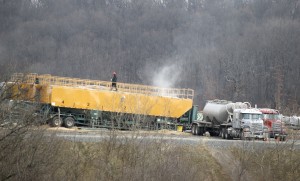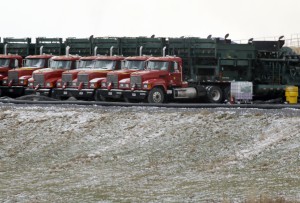Study shows increased hospitalizations in Pennsylvania shale gas region

Keith Srakocic/The Associated Press
A worker walks on top of a container of material used in the gas drilling process in Zelienople, Pa.
A study released today in the journal PLOS ONE shows a rise in hospitalization rates that researchers say correspond to an increase in the number of shale gas wells in Northeast Pennsylvania. The report used information from the Department of Environmental Protection along with data from the Pennsylvania Healthcare Cost Containment Council between 2007 to 2011 in Bradford, Susquehanna and Wayne counties. Bradford and Susquehanna counties experienced a drilling boom during that time period, as well as an increase in the number of patients admitted to hospital.
Wayne county remains free of gas wells due to the de-facto moratorium on drilling in the Delaware River Basin. Wayne county’s hospitalization rates actually decreased in keeping with nationwide trends. Wayne county, which has similar demographics as Bradford and Susquehanna counties, served as the control for the study. Prior to 2007, hospitalization rates were trending down in all three counties.
The most notable impact the researchers found was the association of well density and well proximity with cardiovascular admissions. The report’s authors say this could be related to air pollution associated with gas drilling. The study also reports an association between gas drilling activity and patients admitted for neurological illnesses and skin conditions. The research was conducted by a team from the University of Pennsylvania and Columbia University and funded by the National Institute for Environmental Health Sciences.
Dr. Reynold A. Panettieri, professor of medicine at the University of Pennsylvania and deputy director for the Center for Excellence in Environmental Toxicology, is the lead author of the study, Unconventional Gas and Oil Drilling Is Associated with Increased Hospital Utilization Rates.
He says the data, which included 198,000 records, show a 27 percent increase in hospitalizations for cardiovascular diseases like asthma or stroke, over the 5-year period in 18 zip codes with the highest well density rates in Bradford and Susquehanna counties.
“This was a bit of a surprise because we were only looking at five years of exposure and within that period of time we actually saw increased [hospitalization] rates,” Panettieri told StateImpact. “The period of time is really relatively short. Typically in epidemiological studies we talk about toxic or pollution-induced illness [occurring] over decades.”
As an example, Panettieri said it can take 30 years for asbestos exposure to cause mesothelioma.
But Panettieri says a direct causation has not been made between shale gas drilling and the illnesses that led to the hospitalizations.
“It would be unfair to say [gas drilling] was the cause,” said Panettieri. “What we can say pretty firmly, using two different models, is that there is an association with active wells and proximity to active wells with the likelihood of being hospitalized.”
The researchers did not have access to individual patient data, and so a causal link between exposures and hospitalization could not be made. Panettieri says he hopes to pursue that in future studies.
Dr. Bernard Goldstein, who was not involved in this study but has participated in other fracking health related research, called it an excellent study but with limitations.
“Basically what we’ve been doing is, instead of studying directly the potential health implications of the increase of unconventional oil and gas development, those of us who are researchers are forced to look at this indirectly,” he said.
Goldstein was an author on a recent report that found a correlation between low birth weights and the mother’s proximity to shale gas wells. That study also relied on statewide data, instead of closely monitoring the health of those living near gas wells.
“We’ve gone from what was a few years ago a call to do new research to a paper like this. That changes the call into a cry to do research,” said Goldstein. “This [study] suggests that there may be a significant problem. And it could be associated with shale gas drilling. We can’t just step back and say oh lets wait and see if this is a problem. Nor can we be continually misled by the kind of advertisements we see on TV saying ‘oh we’re reassured we’ve been doing this safely for 65 years.'”
Goldstein said the results of the hospitalization study are both surprising and worrisome. But he cautions that the research does not show that cardiac related problems among residents living in highly drilled areas are all related to gas drilling.
Dr. Panettieri says the research is just beginning.
“We view this as the preliminary data,” he said. “And allows us to now really sharpen our eye as to what to look for in people who are living in and around the wells.”
Panettieri says healthcare costs should start to be factored in when thinking about the costs and benefits of shale gas development.
“We haven’t identified [hospitalizations] as a problem and when we think of a return on investment for hydraulic fracturing we need to be cognizant that on the back end could be the cost of healthcare delivery and health consequences.”

















